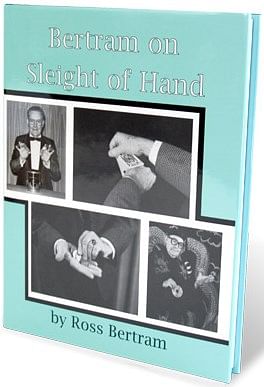Bertram On Sleight Of Hand by Ross Bertram
Reviewed by Jamy Ian Swiss (originally published in Genii August, 1996)

Following the rerelease of the 1978 volume Magic and Methods of Ross Bertram
(reviewed in Genii , March 1995), Lee Jacobs Productions has now done similar duty
with the second Bertram tome, first published in 1983. This is a remarkably dense
catalog of material, spread throughout 13 chapters, and copiously illustrated with
photographs taken by the author and by his wife, Helen. The technical material begins
with three chapters of the author's signature specialty, coin magic, including vanishes of
many sorts, coin folds, penetrations, transpositions, and the kinds of oddball sleights
that can often read terribly, but that made Mr. Bertram's seamless execution of same all
the more astonishing. The third chapter includes work on the predecessor of David
Roth's Karate Coin, the Finger Gimlet, from Coin Magic by Jean Hugard; careful study
here might reveal to slower students and dealers alike that the beauty of this effect lies
in the mysterious penetration of a solid coin, not in the at best amusing but painfully
obvious exchange of a solid coin for a drastically and ridiculously altered one. (Unless of
course you are smart enough to apply the latter prop as cleverly as Derek Dingle might
to the Cigarette Through Quarter, but that is another story.) These three chapters are
followed by one featuring the author's friend, T. Nelson Downs, including
reminiscences, photos of memorabilia, thoughts on the Miser's Dream, and more.
Three chapters of card material follow; the first includes a variety of sleights and tricks,
including top changes, double lifts, revelations, a Vernon false cut, and an interesting
Marlo/Bertram approach to the Haunted Deck. Fans of Cliff Green will doubtless find
Mr. Bertram's Squeeze production of interest. The following card chapter concerns
palming, describing seven interesting sleights, including two approaches to stealing the
top card of the deck into what is commonly referred to as the Gambler's Cop. The third
card chapter consists of 48 pages devoted to the Japanese master, Tenkai. This is the
single most significant body of work addressing the concealment named after its creator,
and is filled with beautiful if technically demanding sleights including transfers, color
changes, switches and much more. While it is certainly true that this concealment has its
practical limitations, it is also true that it can be applied in ways that are virtually
unduplicatable by more conventional means. I recently had the chance to see Guy
Hollingworth, for example, demonstrate some truly delightful applications in his
handling of Sadowitz' Pocket Interchange that would tickle any card handler, whether or
not one actually chooses to attempt to utilize such exotica. The author closes this
chapter with these thoughtful words: "Want to start? Well, begin simply by accepting
the fact that a playing card is no thicker than a piece of ordinary thread, and when held
on a horizontal plane, that is to say flat, is pretty nearly invisible, even without hand
cover." Also worth noting in this chapter is a double-exposed photograph that, while eminently useful as an instructional graphic, also lends the reader a bit more insight
into the author's uniquely inventive mind.
After a brief but enjoyable profile (of the author) by David Drake, mirroring a similar
chapter in the previous Bertram volume, there follows a chapter of general magic which
among eight entries includes a platform version of the torn and restored yarn, an
unusual approach to the hook coin, a carefully taught utility vanish dubbed the B.U.D.
for Bertram's Utility Drop, and a lovely close-up rendition of the torn and restored
cigarette paper which involves a spectator in the action. Chapter ten describes a utility
device and its applications, that the author has dubbed "The Welcome Mat," which looks
like just that and serves as a close-up mat. It also provides the practitioner with secret
assistance via a servante. Chapter eleven consists of 15 pages devoted to the subject of
"One Hand Cuts," including an array of exotic approaches, and concluding with a select
but useful bibliography for anyone interested in the subject. Chapter twelve, entitled
"Count Me In," consists of an assortment of complete routines, primarily but not
entirely with cards. The book concludes with a chapter of "Tips 'n Hints."
When originally released, Bertram on Sleight of Hand never seemed to receive attention
comparable to that of its predecessor; in fact, it appears to never have been reviewed in
a major magic magazine of the rime. This may have at least partially been due to the
somewhat intimidating asking price of $80.00, now, thankfully reduced to a more
reasonable $65.00. Perhaps also, this book, despite its great variety of material, could
not adequately compete with Magic and Methods, with its mix of terrific personal
anecdotes plus timeless Bertram material (the book will forever remain memorable for
its inclusion of, for example, the legendary Kennedy Center Deal, along with the many
stories of Dai Vernon and others of the author's acquaintance). While I admit to still
finding myself a bit more favorably disposed toward Magic and Methods, this volume
deserves to be better known, and the publisher has done a fine job of producing the
book in a quality quite superior to that of the first edition, including the use of,
according to Mr. Jacobs, "heavier, better recycled paper stock, better binding, better
cover cloth, better stamping, [and] better dust jacket...," consistent with the new edition
of Magic and Methods. (Although there, regrettably, the publisher did not see fit to
correct the text in accordance with the errata sheet originally issued by Lloyd Jones. To
the best of my knowledge, however, no such error inventory was produced or warranted
for this volume.) All in all, this work, carefully crafted by one of the great inventors,
technicians, and performers of sleight-of-hand magic of this century, is a better deal for
those who might have missed this substantial book the first time around.
